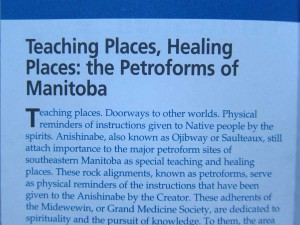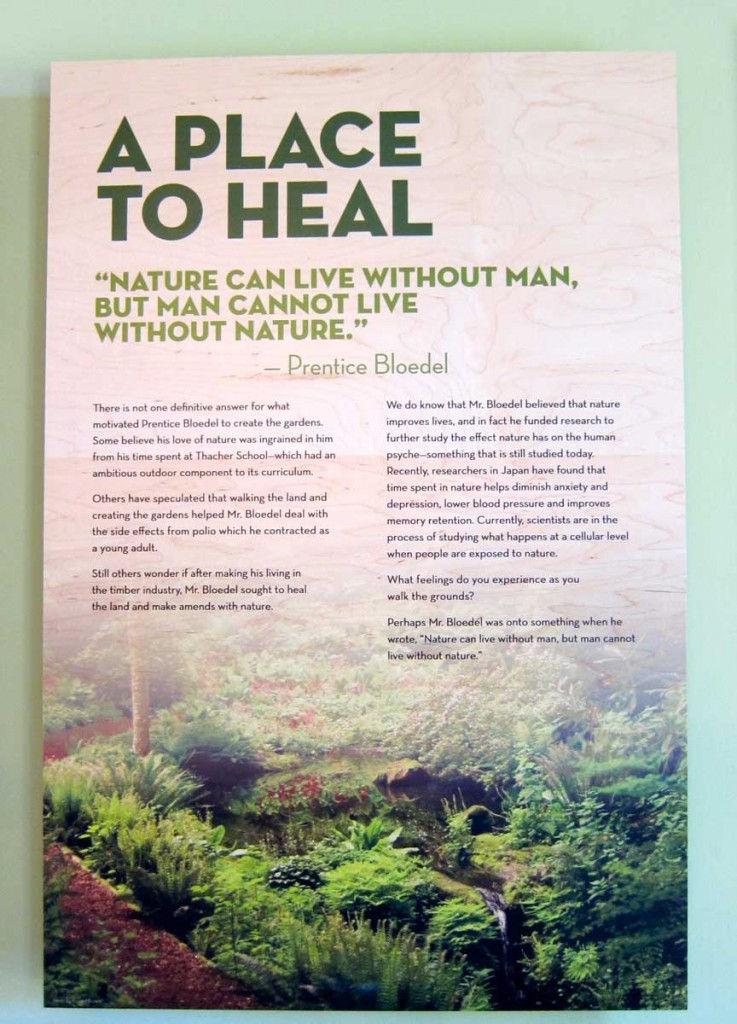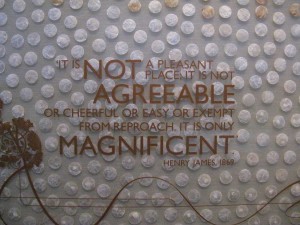
This clipping from a pamphlet about petroforms (patterns on the the ground laid out with stones) in the Province of Manitoba in Canada captures nicely the idea of spirit of place as an aspect of sacred space and a gateway to the supernatural.
The idea of spirit of place has echoed through the ages. It derives from an ancient and widespread belief that particular bits of the world are occupied by gods, or spirits who have to be propitiated. This was a key element of Roman religion. Genius loci is the Latin for the spirit or guardian deity of a place and is a phrase that has been adopted in English and into other languages and achieved a broad degree of popularity. A quick Google search for genius loci brought up links to a recent art exhibition featuring the work of Chinese artist Ai Weiwei and others, an American kickstarter campaign for a book on tales of the spirit of place, the name of travel company specializing in Italy, and an art project in Weimar in Germany.
While spirit of place/genius loci was originally, and to some people still is, closely associated with beliefs about the sacred character of places, it has been increasingly secularized. This is apparent in the Wikipedia definition of spirit (or soul) of place as “the unique, distinctive and cherished aspects of place.” The term “sense of place” is often, and I think misleadingly, used to mean much the same (see my earlier post on Sense of Place).
Probably the best known substantial investigation of spirit of place is the book Genius Loci by Norwegian architect Christian Norberg-Schulz, which I summarize below. But I’ll begin here with a overview by Isis Brook of the range of notions the concept embraces and some other discussions because I am not trying to offer some definitive statement about spirit of place but to give some sense of the diversity of thinking it has invited. All sources are fully identified at the end of this post.

And this photo of a poster at Bloedel Gardens on Bainbridge Island in Washington State, which also stresses the healing role of place, is an example of a secular, even scientific idea of spirit of place. [Bloedel was for decades a dominant figure in the forestry industry – his name is preserved in the company MacMillan-Bloedel]
Brooks’s essay is in a book on ethics and the built environment. She begins by noting that “spirit of place” is an ambiguous rather than a robust idea, and then poses the questions: Does everywhere have “spirit of place”? Is there a boundary to it? Are there regional spirits of place? What is the role of human beings in this – is spirit of place a projection of humans? (I think the answers are, respectively, Yes; Not a clear boundary; Yes; according to some writers Yes and others No)
She then identifies the following range of ideas that have been associated with spirit of place:
- abodes of special beings, spirits, fairies
- energy fields – a point of intense energy
- authenticity
- narrative, with layers of history, preferably not preserved
- local distinctiveness
- the empowerment of ordinary people
- essence or interiority
- character – the place appears as it is in its individuality
- ecosystem and the way the natural systems work together
- pantheism or a manifestation of God’s creation
- panpsychism – the idea that all things, even inanimate, have their own consciousness or mind-like qualities
- health of a place or emergent property
She suggests that one way around this “hopeless confusion” is to accept that spirit of place describes a reality that is based neither on an inventory of the contents of somewhere nor on a description of our feelings about them but has its own legitimacy as a means to prevent homogenized design.

This is Edith’s House in the Ballard neighborhood in Seattle. She refused all offers to move out when the new building (it has a Trader Joe’s, Ross, a fitness studio) was developed around her property. The text, taken from a sign on the building, notes that the building will be preserved and “will respect the history of the place.” In the meantime it illustrates Norberg-Schulz’ dismay about the failure of modern architecture to respond to genius loci.
Lawrence Durrell Spirit of Place 1969
This book by the novelist Lawrence Durrell is collection of letters and notes he wrote to capture his reactions to places in Corfu, Egypt, Greece, Argentina, Britain, France, (and was one of the first books with “place” in its title that actually discussed the concept a bit). His thinking was laced with evocative environmental determinism – the largely discredited idea that environments manifestly influence behaviour and culture.
“As you get to know Europe slowly,” Durrell wrote, “tasting the wines, cheeses and characters of the different countries, you begin to realize that the important determinant of culture is after all – the spirit of place.” Durrell doesn’t believe, for example, that the British character has changed a jot since Tacitus described it, and “as long as people keep getting born Greek or Italian or French their culture productions will bear the unmistakable signature of the place.” He suggests that if you could exterminate the French at a blow and resettle the country with Tartars, within two generations the national characteristics would be back – including restless metaphysical curiosity, tenderness for good living. “This is the invisible constant in a place with which an ordinary tourist can get in touch just by sitting with a glass of wine in a Paris bistrot.”
This is the reality of places that cannot be identified by inventories of contents, to which Isis Brook refers. It does not stand up to critical scrutiny but it’s not easy to keep the sort of views that Durrell expressed from slipping into our thoughts. They explain cultural and other differences so neatly. Henry James’ claim about the genius loci of London is less straightforward but also comes closer to the inherent complexity of a particular place.

This enigmatic quote from Henry James about London conveys some of the ambiguity of spirit of place. It is on a wall inside the Museum of London.
Here’s a more recent example of the idea of a deterministic spirit of place from The Somnambulist, a novel by Jonathan Barnes, but with a negative spin:
“He could feel the weight of the past pressing down upon him as he walked…He found himself recalling the notion of genius loci, that fanciful conviction that a place itself materially affects the individuals who pass through it. If this place had any tangible effect upon its inhabitants then it was surely a malign one.“ (61-2).
Jane Brown’s 2001 book Spirits of Place seems to apply this deterministic line of thinking to novelists themselves. It is a sort of thematic biographical study of Virginia Woolf, E.M. Forster, Rupert Brooke, Carrington, and E.P.Hartley, all of whom were famous in some way and connected with the Bloomsbury group, and all of whom “possessed an acute sense of place” (p.xiv). But she blends notions of landscape, sense of place and spirit of place in her discussion and offers a relatively subtle account of the influence of place on their work.
Consulting the Genius of Place
In one of his poems that the 18th century English poet Alexander Pope satirized the life of landed gentry, especially their inclination to engage in ill-conceived landscape schemes on their estates that tried to echo Versailles. Instead he encouraged landscape gardening that responded to nature. His explicit advice was to:
“Consult the genius of place in all”
This is widely quoted in discussions of spirit of place, for instance, the 2009 book by environmentalist Wes Jackson Consulting the Genius of the Place: An Ecological Approach to a New Agriculture. What it meant for Pope and those who have quoted it, is the importance of attending to the distinctiveness of landforms and landscapes, and of local natural systems and environmental processes.
Christian Norberg-Schulz Genius Loci: Towards a Phenomenology of Architecture 1980
This foundation book in the study of place is generously illustrated with photos intended to illustrate particular themes and to convey aspects of genius loci. Almost all of them are of pre-modern buildings and townscapes or natural landscapes from Europe and some from North Africa.
Norberg-Schulz explicitly adopts a phenomenological and Heideggerian approach, suggesting (p.5) that: “the spaces where life occurs are places…A place is a space which has a distinct character. Since ancient times the genius loci, or spirit of place, has been recognized as the concrete reality man has to face and come to terms with in his daily life. Architecture means to visualize the genius loci and the task of the architect is to create meaningful places, whereby he helps man to dwell.”

Genius loci does not always involve exceptional landscapes and buildings. This is the edge of Old Oraibi, a Hopi village in New Mexico, that is thought to be the longest continuously-occupied settlement in North America and therefore an excellent example of Norberg-Shulz’s idea of ‘stabilitas loci.’
He recognizes (p.18) that: “The structure of a place is not a fixed, eternal state.” But this does not mean that the genius loci changes or gets lost because identity can be conserved. Indeed it has remained a living reality throughout the course of history. “Stabilitas loci is a necessary condition for human life.”
Norberg-Schulz’ substantive interest is in architecture and its intentions. He argues that it is not enough for architects to make practical towns and buildings. Architecture has to concretize genius loci, and he follows Heidegger’s thinking to suggest that this is done by creating buildings which gather the properties of the place and help people to dwell poetically and to know how they belong to a place.
J.C. Holt Spirits of the Place 2009
In the discussions by Brook, Durrell and Norberg-Schulz the idea of genius loci is almost entirely secular. They write about properties of landscapes and buildings that may be elusive but can, for the most part, be seen. Holt’s book is about Buddhism and the power of place in relation to spirit beings in Laotian traditional culture. (Holt was a student of Mircea Eliade the author of a major work on sacred and profane space).
Holt discusses studies of religion in Asia made in the 1930s by Paul Mus who maintained that the inhabitants of ancient India, Indo-China and southern China believed in spirits – disembodied human souls – that are present in all thing in all places. Mus argued for “a notion of power found in or attributed to a given, specific place, a power that accounts for the dynamism of life associated with that locality.” This power is impersonal yet can be personalized through the social experience of events. “To the genius loci, the personification of the energies of the earth, was owed the prosperity of the territory occupied by those who united to worship it, and were defined as a group by this unity.”
These ideas inform Holt’s investigation of spirits in Laotian tradition culture, and how some spirits (they are called phi – you can get some sense of them from Colin Cotterill’s mystery stories about Dr Siri Paiboun, which are set in Laos) may be associated with places, yet enigmatically refuse to be embodied or pinned down, and are unpredictable. Holt also writes about the transformation of beliefs in these through commercial and political actions that have marketed aspects of Laotian religious culture.
In an entirely different yet somehow similar vein is a short essay by sociologist Michael Bell “The Ghosts of Place.” He writes that: “A common feature of the experience of place is the sense of the presence of those who are not physically there” – the genii loci. He claims that we construct places in large measure by the ghosts we sense inhabit them. You may disagree, and he is presumably using “ghosts” at least partly in a metaphorical meaning, but it is an interesting contemporary version of the spirit of place.

The Ghosts of Place. The Village of Amulet in Saskatchewan has entirely disappeared except for this marker and plaque.
References
Barnes, Jonathan, 2009, The Somnabulist, (New York: Harper and Row)
Bell, Michael, M. 1997 “The Ghosts of Place” Theory and Society, 26, 813-836
Brook, Isis, 2000 “Can ‘Spirit of Place’ be a guide to Ethical Building” in W. Fox (ed) 2000 Ethics and the Built Environment, (London: Routledge), 139-151
Brown, Jane 2001 Spirits of Place: five famous lives in their English landscape (London : Viking)
Durrell, Lawrence, (1969) Spirit of Place: Letters and Essays on Travel (London: Faber and Faber)
Holt, J.C., 2009 Spirits of the Place: Buddhism and Lao Religious Culture (Honolulu: University of Hawai’i Press)
Norberg-Schulz, C. 1980 Genius Loci: Towards a Phenomenology of Architecture. (New York: Rizzoli).
Pope, Alexander, Epistles to Several Persons: Epistle IV
Tomich, S. 2002 “Genius Loci: A Poetic Approach to Urban Design” Plan Canada, Vol 42, 3 , 32034
.